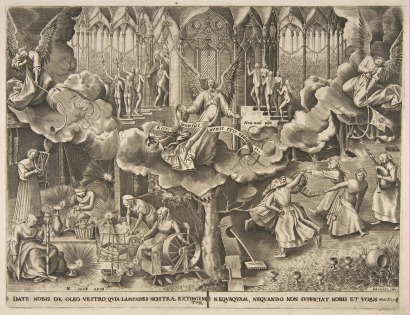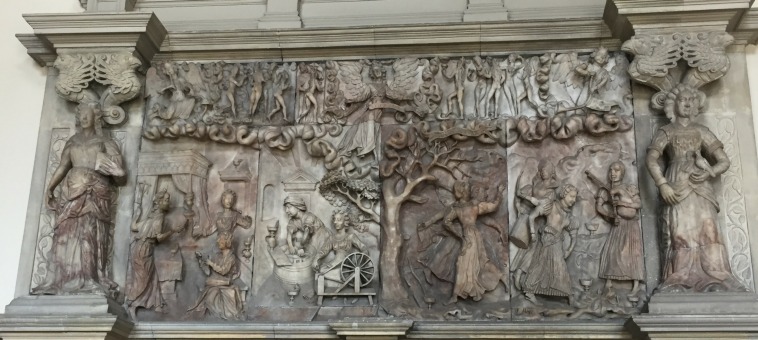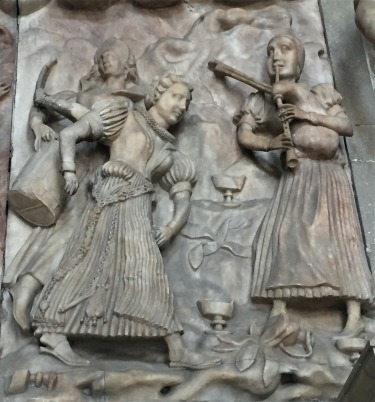The Bagpipe Society
The Burton Agnes Bagpiper

I have long been familiar with the image of the female bagpiper at Burton Agnes Hall in East Riding of Yorkshire. I can remember being absolutely wowed by it the first time a friend showed me a photograph of the alabaster carving which she had found in a book on Elizabethan and Jacobean architecture. For me, this one carving scored on a number of levels: it was a bagpiper, it was a FEMALE bagpiper and it was Elizabethan.
Renaissance art and architecture taps into my soul in a way that is difficult to explain but in many years of visiting various churches, edifices, grand and not so grand houses, I seem to gravitate towards design and features from the 16th century and the Tudor aesthetic commands a particular draw. Couple that with my never ending quest to ‘find the bagpiper’ when visiting a historic building and you will begin to see why Burton Agnes, built in 1603, would hold a special place for me.
There can be a danger when seeing a bagpipe carving in England to jump to the conclusion that one has found that most elusive of objects – the English bagpipe! A dangerous assumption to make. With the proliferation and availability of prints from the mid-16th century onwards, there was a definite trend for English artisans to copy designs from Continental prints, especially those from Flanders, and then make them their own. There is a fascinating book by Anthony Wells Cole, (Art and Decoration in Elizabeth and Jacobean England) where he shows the original continental print alongside the English interpretation of the design. There are hundreds of example of this fashion depicted in architectural designs, embroideries, tapestries, book illustrations or other artefacts.

This is definitely the case with the bagpiper at Burton Agnes. The player of the pipes is one of the five foolish virgins based on a design by Pieter Breughel the Elder. The original engraving was by Philips Galle and it was published in Antwerp by Hieronymus Cock, sometime in the early 1560’s. The parable on which the illustration is based is from St Matthew’s Gospel and concerns the Wise and Foolish Virgins. In the print, the wise virgins are shown working hard preparing, washing and spinning wool, keeping their lamps full of oil and thus they enter the kingdom of heaven. Meanwhile, the foolish virgins have discarded their work and have instead decided to enjoy themselves by dancing and playing, and neglecting to get oil for their lamps. Whilst on one level this sounds to me to be the far better option – the foolish ones are denied access to heaven, or, as in the original parable, they do not get the bridegroom. Oh well. It was a popular parable from the medieval period, with its message of being prepared for the day of judgement, and it has been a source of artistic inspiration, not only for Breughel, but for such luminaries (sorry!) as William Blake, Johan Sebastian Bach and Blind Willie Johnson, amongst many others.
The overmantle carving at Burton Agnes is an excellent translation from the print into stone and other than some ornate gothic architecture, all of the detail is there in the alabaster version. Despite having known the image for so long from various photographs, I was particularly excited at the prospect of seeing it for real. You never really ‘happen to be passing Burton Agnes’ as it is a bit out of the way so, on a recent trip to Yorkshire, a route was planned to visit it. I was completely and utterly blown away and despite knowing the image so well, I wasn’t really prepared for the impact of seeing the sheer size, scale and magnificence of the alabaster overmantle and hall screen in the Great Hall.
Coming to the bagpiper herself: she really jumps out of the screen and, whilst it seems a foolish thing to say about a carving, she really is in 3D! The drones protrude outwards and the figure is definitely dancing.

So, is this an English bagpipe? Probably not - but she is definitely an English bagpiper. Whilst the print is Flemish and the design of the bagpipe reflects the forward facing drones of a Flemish bagpipe, the player’s clothing has definitely been adapted from that shown in the print to reflect an English style of dress. The coif (headdress) and sleeve design are English not Dutch, as is the pleating on the kirtle (skirt). The carver has adapted the costume to reflect English tastes and who can say for sure whether or not that type of bagpipe was played in England? There were considerable trade and cultural links with Flanders throughout the 16th century, especially along the east coast, and there’s every reason to suppose that musicians and their instruments also found their way from the continent to England. So tt is not beyond the realms of possibility that a Flemish style bagpipe was played in England.
The rest of Burton Agnes did not disappoint and there were delights throughout the Hall – not least the fantastic collection of impressionist art and modern sculpture by the likes of John Makepeace. So, whilst it is out of the way, do make the detour to visit this house. Oh, and much to my delight, I also found another bagpiper there, but this time in a painting.
From Chanter Summer 2018.
- Data Processing Notice (GDPR)
@BagpipeSociety on X (formally known as Twitter)
TheBagpipeSociety on Instagram
 BagpipeSociety on Facebook
BagpipeSociety on Facebook
Something wrong or missing from this page? Let us know!
